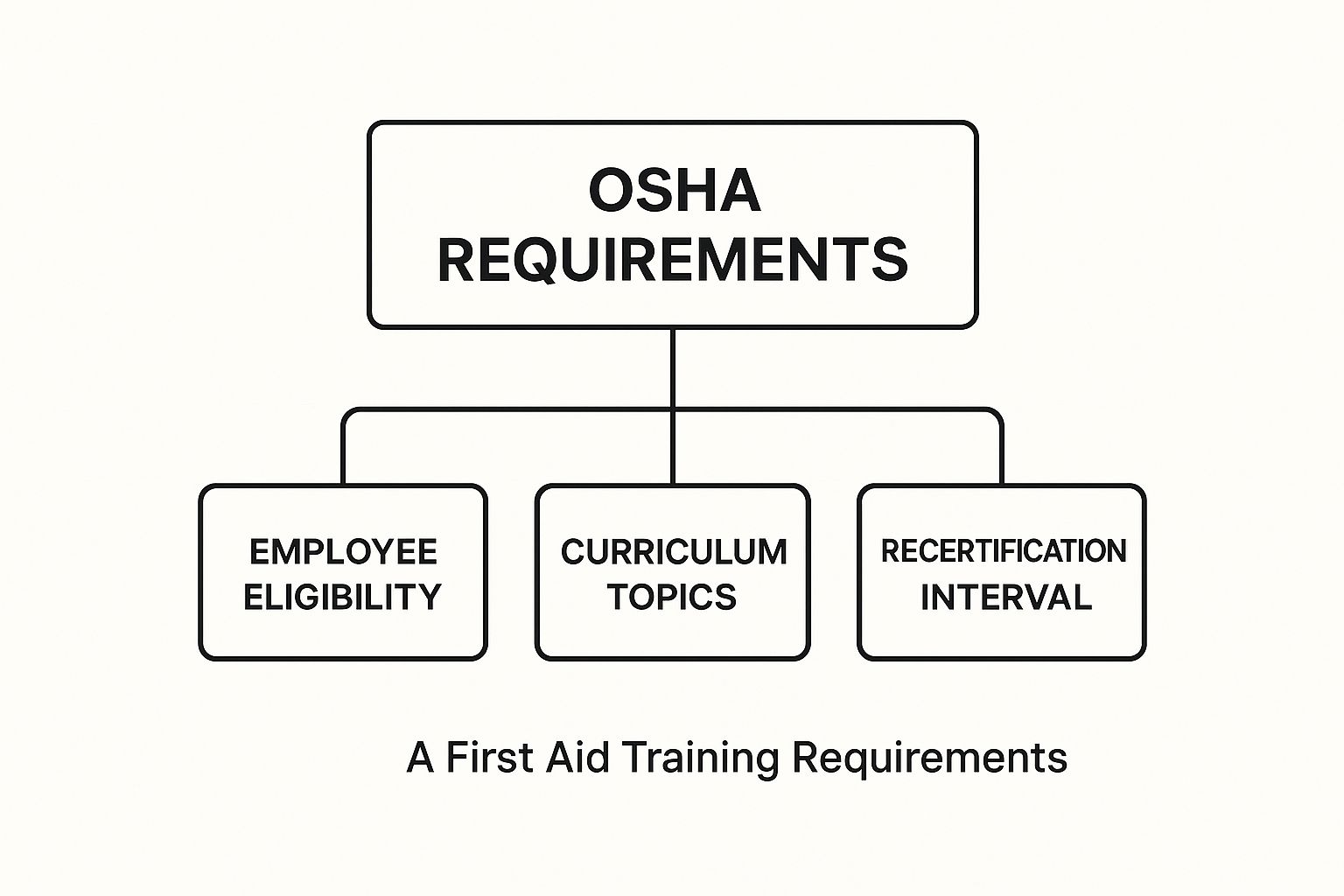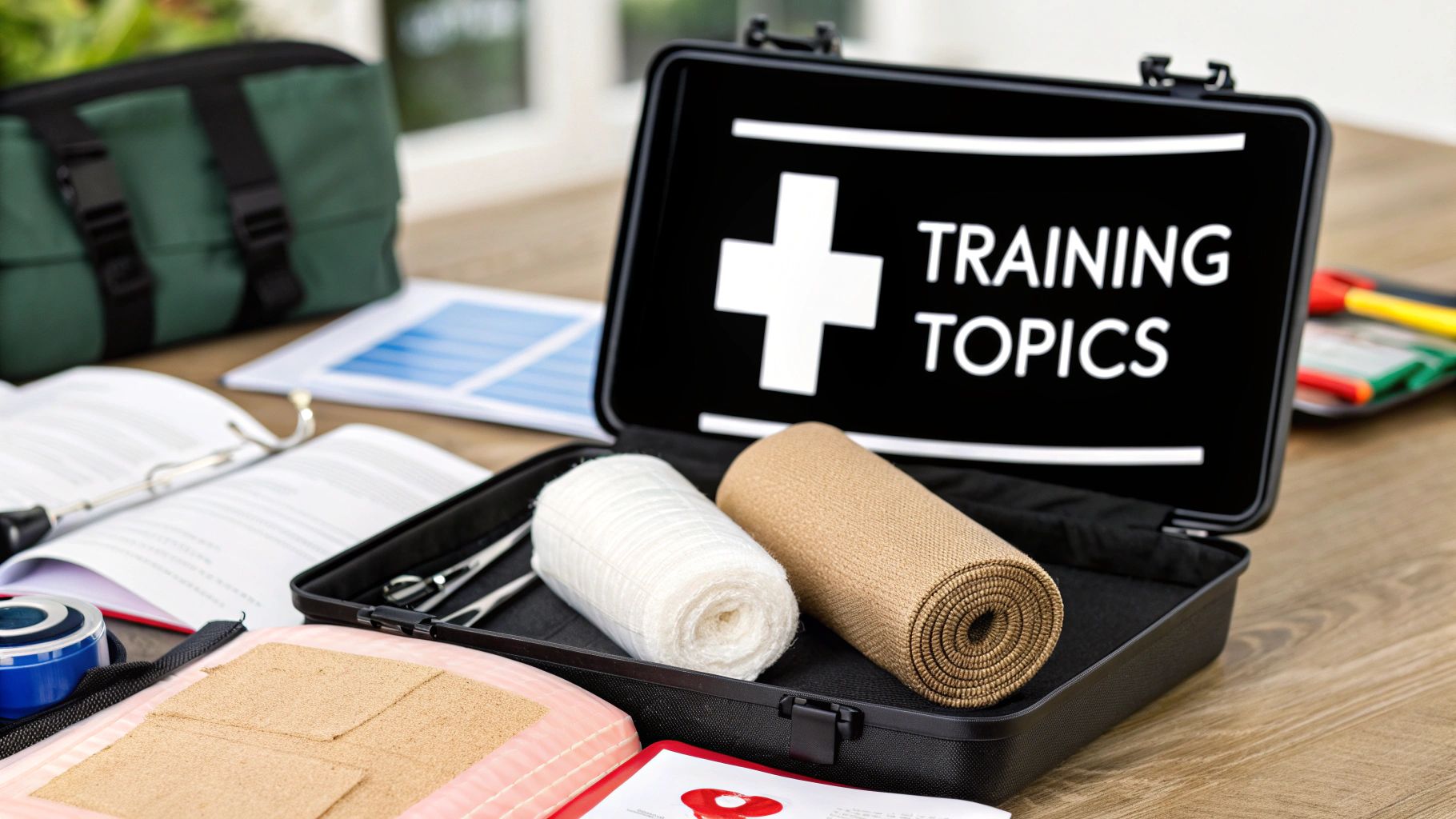Navigating OSHA's first aid rules can feel tricky because they aren't a simple, one-size-fits-all mandate. The entire system is built around a single, practical question: how fast can an injured employee get professional medical help? A high-risk construction site miles from the nearest hospital has a much bigger responsibility than a quiet office right next door to an urgent care clinic.
What Are the Core OSHA Requirements for First Aid?
Let's clear up some of the confusion right off the bat. The Occupational Safety and Health Administration (OSHA) doesn't demand that every single employee in every company gets a first aid certification. Instead, their approach is grounded in a common-sense, risk-based idea: your first aid program has to be adequate for the actual hazards your team faces every day.
This means an administrative office and a busy manufacturing plant have completely different needs. The biggest factor determining your specific training duties is your "near proximity" to a hospital, clinic, or infirmary. If professional medical care isn't just a few minutes away, you absolutely must have trained people on-site ready to give immediate first aid.
The Foundation of a Compliant Program
OSHA's approach is flexible, but it's not a free-for-all. A solid workplace first aid program is built on four essential pillars: management leadership, worksite analysis, hazard control, and dedicated safety training. It's a framework designed to make safety a core part of your operations, not just an afterthought.
You can dig deeper into these principles in OSHA's Best Practices Guide, but here's the bottom line. True compliance is about more than just sticking a first aid kit on the wall. It’s a real strategy.
- Assess Your Risks: You need to pinpoint the specific dangers your employees are exposed to.
- Create a Plan: Based on those risks and your location, figure out who needs training.
- Provide Resources: This means having the right first aid supplies and the right trained people.
- Maintain the Program: Keep training up-to-date and make sure supplies never run out.
To help you visualize how these pieces fit together, we’ve put together a table summarizing the core components of a program that OSHA would consider effective.
Four Pillars of an OSHA Compliant First Aid Program
Seeing these pillars in action shows that a compliant program is an active, ongoing effort, not just a box-ticking exercise.
This infographic also helps break down the core components, from identifying who needs training to understanding how often it's needed.

As the diagram shows, every decision—from the course curriculum to the renewal schedule—flows directly from OSHA's core principles. It creates a clear, logical path to keeping your team safe.
For a complete breakdown, our full guide to OSHA first aid requirements covers every detail you need. Getting a handle on this risk-based model is the single most important step you can take toward building a program that doesn't just meet regulations, but actually protects your people.
How to Conduct a Worksite Hazard Analysis

Think of a worksite hazard analysis as creating a custom safety map for your business. It's the first real step in building a first aid program that actually works for your team—one that goes beyond just checking a box and gets to the heart of the dangers your people face every day. This isn't about generic compliance; it's about building an intelligent, tailored safety plan.
The whole process kicks off with one clear goal: find and assess the potential dangers in your workplace. This means looking at everything from the obvious stuff, like heavy machinery on a factory floor or fall risks on a construction site, to the less visible threats, like ergonomic strains in the office or chemical exposures in a lab.
A good hazard analysis is what makes sure your OSHA first aid training requirements are perfectly aligned with your environment.
Reviewing Your Safety History
Believe it or not, one of the best tools you have is your own past. Your company's injury and illness logs, especially the OSHA Form 300, are an absolute goldmine of information about what could happen next. Don't just file these reports away—dig into them.
Start looking for patterns. Are slips and falls happening in the same area over and over? Do certain jobs lead to repetitive strain injuries? This data tells you exactly what kind of incidents are most likely to happen again, letting you prepare your first aid response for what’s probable, not just what’s possible.
By examining past incidents, you transform your safety program from a reactive measure into a proactive strategy. You're not just waiting for an accident; you're anticipating it and preparing your team to handle it effectively.
Performing a Physical Walk-Through
Next up, get out of your chair and walk the floor. A physical inspection is the only way to spot hazards that just won't show up on paper. As you walk through your worksite, think about the entire process of each job from start to finish.
What materials are people handling? What tools and machines are they using? How is the workspace laid out? Look for potential red flags at every single step.
- Environmental Dangers: Check for simple things like poor lighting, wet floors, or extreme temperatures.
- Equipment Risks: Take a close look at machinery. Are safety guards missing? Do you see any obvious signs of wear and tear?
- Ergonomic Issues: Watch how your employees are working. Are they lifting improperly or slumping in chairs with zero back support?
This hands-on approach gives you a real-world picture of the risks in your workplace.
Documenting and Prioritizing Hazards
Once you've gathered all this info from your records and your walk-through, the last step is to get it all down on paper and prioritize it. Create a detailed list of every potential hazard you found, from the most serious to the least. This lets you focus your time and money where they'll make the biggest impact.
For each hazard, rate its potential severity and the likelihood of it happening. A frayed electrical cord in a high-traffic hallway, for instance, is a huge priority. This organized list becomes the blueprint for your entire first aid program, telling you exactly what training your team needs and what supplies you absolutely must have on hand.
Determining Who Needs Training and How Often

Alright, so you’ve mapped out the potential hazards lurking in your workplace. What’s next? Now you need to figure out exactly who needs first aid training and how often they should be refreshing those skills.
This is where OSHA's "near proximity" rule comes into play. It’s less about job titles and more about a simple factor: time.
The "Near Proximity" Rule Explained
At its core, the question is straightforward: If someone gets seriously hurt, how long will it take for an ambulance to arrive? Your answer to that question dictates your training responsibilities.
OSHA doesn't measure this in feet or miles. Instead, proximity is all about the time it takes for Emergency Medical Services (EMS) to get to your door. This makes the rule flexible enough for any business, whether you’re in a bustling downtown or out in a rural area.
OSHA defines 'near proximity' as being within a 3–4 minute travel time for high-risk worksites, like construction sites or manufacturing plants. For lower-risk office environments, that window extends up to 15 minutes. If professional help can't get to you within those timeframes, you're required to have at least one employee trained in first aid and CPR on every single shift.
Setting a Training and Retraining Schedule
First aid and CPR skills are perishable. You can't just learn them once and expect to remember everything years later. Think of it like a muscle—if you don't use it, you lose it. That’s why regular retraining is a non-negotiable part of meeting OSHA first aid training requirements.
A solid training calendar is your best friend here, ensuring your team is always ready to act.
- CPR/AED Certification: CPR relies heavily on muscle memory. That's why certifications from organizations like the American Heart Association and the American Red Cross typically need to be renewed every one to two years.
- First Aid Certification: General first aid skills usually have a longer shelf life, with certifications lasting two to three years, depending on your training provider.
- Specialized Training: If your team is trained to use things like naloxone for opioid overdoses or an epinephrine auto-injector for allergic reactions, these might have their own unique renewal schedules based on state laws or best practices.
Recertification isn't just about ticking a box for compliance. It’s about making sure that when a real emergency happens, your trained responders can act with confidence and skill, not hesitation.
As you plan your schedule, it's a good idea to think about your broader training program. Exploring effective employee compliance training strategies can give you a great framework for building a culture of safety. Ultimately, a reliable training calendar is what keeps your team prepared for anything.
Stocking Your First Aid Kit for Compliance
Your first aid kit is so much more than a box of bandages collecting dust in a cabinet. Think of it as a critical, front-line tool in your workplace safety plan. It has to be stocked and ready to handle the specific injuries you identified during your hazard analysis.
Now, OSHA's own language on the subject is famously broad—they just require that supplies be "adequate." But thankfully, they don't leave employers completely in the dark.
Instead, OSHA points everyone toward the ANSI/ISEA Z308.1 standard. This standard is the accepted benchmark for what "adequate" really means in practice. It gives you a clear, detailed roadmap for stocking a first aid kit that actually meets the needs of your team and keeps you in line with OSHA first aid training requirements.
Class A vs Class B Kits
The ANSI standard isn't a one-size-fits-all checklist. It smartly breaks down first aid kits into two distinct categories based on the risk level of your work environment. Getting this right is a huge part of compliance.
Class A Kits: These are your go-to for low-risk workplaces. Think of a typical office, a retail store, or a small administrative building. They’re stocked with a basic assortment of supplies to handle common minor stuff, like small cuts, scrapes, and minor burns.
Class B Kits: These are built for tougher, higher-risk environments. We're talking about construction sites, warehouses, and manufacturing plants. Class B kits have a much broader range and larger quantity of supplies to manage more serious injuries—like severe bleeding, fractures, and major wounds—that are more likely to happen in these settings.
Choosing the right kit isn't just about counting employees; it's about realistically assessing the potential for harm. A small welding shop with only five employees has a much higher risk profile than a 50-person call center, making a Class B kit the obvious and appropriate choice. For a closer look, a deep dive into creating an OSHA compliant first aid kit can give you even more detail on specific contents.
To help you see the difference, here's a quick breakdown of the minimum requirements for each type of kit based on the ANSI Z308.1 standard.
Class A vs Class B First Aid Kits (ANSI Z308.1 Standard)
Remember, this is the minimum. Your own hazard assessment might tell you that you need more of certain items or even additional supplies not on this list.
State-Specific Regulations
It’s crucial to remember that federal OSHA sets the floor, not the ceiling. Some states run their own OSHA-approved programs and have more specific, often stricter, rules.
For example, California is governed by Cal/OSHA, and their regulations for first aid kits are much more precise. They dictate minimum quantities based on employee numbers and require specific items like a set number of burn treatments, multiple cold packs, and at least one CPR mask per kit. Always check to see if your state has its own plan and regulations that go beyond the federal standard.
Ultimately, your first aid kit should be a direct reflection of your worksite analysis. Every item inside should have a purpose tied to a potential, real-world injury your team could face. This turns your kit from a passive compliance item into an active, life-saving resource.
Managing Your Program and Keeping Records

A great first aid program can fall apart fast if you don't manage it properly. Let's be honest, the administrative side of OSHA compliance isn't the most exciting part, but it’s what gives your program its structure and staying power. This is about creating a living, breathing safety system—not just a folder of paperwork you dust off once a year.
Solid documentation shows you’re serious about safety, gives you a leg to stand on during an OSHA inspection, and makes sure your program actually works day in and day out. Think of it as the backbone that holds everything else up.
Maintaining Training Records
One of the most important administrative tasks is keeping meticulous training records. When an OSHA compliance officer shows up, you can bet they'll ask to see proof of training. Your records need to be organized, clear, and easy to find.
This paperwork is your hard evidence that you're meeting the OSHA first aid training requirements for your specific workplace.
For every employee, a complete training record should have:
- Employee's Name: Simple, but essential. Who got trained?
- Training Date: The exact date they completed the certification course.
- Course Content: A quick summary of what the training covered (e.g., Adult CPR/AED, Basic First Aid).
- Training Provider: The name of the company that ran the training (like us, Ready Response).
- Instructor's Name: The person who led the session.
- Certification Expiration Date: This is key. It tells you exactly when you need to schedule renewals.
Keeping all this straight is crucial, especially when you're juggling different renewal dates for your team.
Documenting First Aid Kit Inspections
Just as critical as training logs is the documentation for your first aid kit inspections. OSHA's rule is that your supplies must be "adequate" and ready to go at all times. The only real way to prove you're doing this is by keeping a log of regular checks.
These inspections make sure your kits are always fully stocked and nothing has expired. A simple log sheet taped to the inside of the kit or kept in a safety binder is all you need.
An inspection log is your proof of due diligence. It shows an inspector that you are proactively managing your safety resources, not just reacting after an incident occurs.
Good recordkeeping in every area of workplace safety—from training certificates to incident reports—builds a stronger defense and, more importantly, a stronger safety culture.
Partnering with a Professional Training Provider
Knowing OSHA's rules is one thing, but actually putting them into practice with confidence is a whole different ballgame. This is exactly where bringing in a professional training organization can be a game-changer for any business trying to nail its OSHA first aid training requirements. A good provider takes all the guesswork out of the equation, delivering training that’s always up-to-date with the latest guidelines.
When you outsource your safety training, you free up valuable time and people. Instead of pulling an employee from their regular duties and asking them to become a certified trainer, you can bring in seasoned experts who live and breathe emergency response. This guarantees your team gets high-quality, engaging instruction from pros who know how to build real, life-saving skills.
The Value of Hands-On Instruction
For skills like CPR and first aid, what you know is only half the battle—muscle memory is just as critical. Professional providers specialize in hands-on, instructor-led courses that are a world away from a simple online module. This practical, in-person training builds the confidence your employees need to act decisively when a real emergency strikes.
Partnering with a certified provider like Ready Response provides your team with verifiable skills and gives you true peace of mind, knowing you are prepared for any inspection or emergency.
These partnerships don't just check a compliance box, either. They can also open up new opportunities for team members who discover a passion for safety. Our guide on the first aid instructor course shows how these dedicated individuals can take their skills to the next level.
Ultimately, professional training ensures your program isn't just compliant—it's effective and ready for action.
Common OSHA First Aid Questions Answered
Working through the specifics of OSHA can feel like untangling a knot. You've got questions, and getting clear, straightforward answers is the first step toward building a safety program that actually works. Let's tackle some of the most common questions employers have about OSHA first aid training requirements.
Does Every Single Employee Need First Aid Training?
Nope, not always. OSHA’s rules are built around two key factors: risk and how close you are to professional medical help.
If your office is just a stone's throw from a hospital or clinic (think 3-4 minutes for a high-risk site like a factory, or up to 15 minutes for a low-risk office), you might not need to have a designated first aid provider on staff.
But here’s the catch: if you can't get professional help within those timeframes, you must have people on every single shift who are certified in first aid and CPR. The decision really comes down to a good, honest look at your worksite hazards and your distance from the nearest emergency room.
Are Online-Only First Aid Courses OSHA Compliant?
This is a big one, and the answer is a little tricky. OSHA doesn't give a thumbs-up or thumbs-down to specific training brands, but they are crystal clear about one thing: hands-on practice is non-negotiable.
A formal letter of interpretation from OSHA back in 2007 clarified that online-only training just doesn't cut it. Why? Because you can't learn how to properly perform CPR or bandage a wound just by watching a video.
For skills like CPR and wound care, practical application is essential. An effective training program must include a hands-on component where an instructor can observe and correct a student's technique.
That’s why a blended learning course is your best bet. It combines the convenience of online coursework with a crucial in-person skills session. This way, you ensure your team isn't just compliant on paper—they're genuinely prepared to act. For a deeper dive, our Complete Guide to First Aid Heartsaver Certification breaks down why hands-on models are so important.
What Happens If We Don’t Meet OSHA Standards?
Ignoring OSHA's first aid standards can bring some pretty serious heat. If a compliance officer inspects your workplace and finds your first aid program is lacking for the hazards present, you could be looking at significant citations and fines.
The financial hit can be big, but the fallout doesn't stop there. Failing to comply opens your company up to greater liability if an accident happens. More importantly, it puts your people at a much higher risk of serious injury or worse. While our focus is on OSHA, you may find it helpful to look at resources addressing questions about being hurt at work to understand the legal side from an employee's perspective.
At Ready Response, we provide OSHA-compliant, hands-on first aid and CPR training that equips your team with the skills and confidence to act decisively in an emergency. Visit us at readyresponsepa.com to schedule on-site training that ensures your business is both safe and compliant.
